Resources
We are located at:
North Campus BuildingRoom 120
Western University
1151 Richmond St. N.
London, Ontario
N6A 5B7 Canada
geocollections@uwo.ca
The Richard W. Hutchinson Geoscience Collaborative Suite Display
Geological collections grow constantly through donations. Every acquisition increases the depth and extent of Western University’s potential for outreach, teaching and research. With over 50,000 rock and mineral specimens available to educators and researchers through the Richard W. Hutchinson Geoscience Collaborative Suite, there is so much to discover.
There are two collections in the Earth Sciences Department at Western University, housed at the Richard W. Hutchinson Geoscience Collaborative Suite - the Suffel Ore Deposits Collection and the Dana Minerals Collection.
These collections were established in the early 1940s and specimens were primarily donated by Western Faculty, such as Dr. G. Gordon Suffel, Dr. Richard W. Hutchinson, Dr. Robert W. Hodder, Dr. Norm A. Duke, and many others. Along with these important suites are donations from private individuals and corporations.
The majority of the specimens in this display are a selection from some of the most recent donations to our department collections. A short description of the Al Kington Collection is provided below, and short descriptions of the other donations are provided with their associated specimens at the very bottom of the page.
Al Kington Collection - Kingsbrook Gemcraft – The “Rock Shop”
This description was provided to Western University by Nancie Irving, daughter-in-law of Al Kington, as a history of the Kington Collection. The Kington Collection was donated by Nancie to the Western University Earth Sciences Department in 2022. A small number of specimens from this collection are part of this display.
Alfred Thomas Kington (1912-1984) came from Wales in 1928 to Atwood, Ontario, and a few years later relocated to the Yarmouth Township (Dexter) area. In 1936 he and first wife Margaret Jones (1916-2006) were married. They worked on the family farm of Margaret’s father Tom Jones in Dexter, doing market gardening, taking produce to as far away as Toronto. Al was oversees during War II, was wounded in Holland, and returned to the St. Thomas area. He became the Governor of the Elgin County Jail. They had two sons, Darrell and Brian. In 1952, Al and Margaret separated, with Al moving to London where he worked at the 27 Central Ordinance Depot (COD) as a Safety, Security and Fire Prevention Officer. Margaret remained in the St. Thomas area working as a nurse at the St. Thomas Psychiatric Hospital after leaving farming.
Alfred married Eileen Rider (1917-2003) and moved to Dorchester in 1954. Eileen was an Occupational Therapist at the St. Thomas and London hospitals. In the early 1960s, they started collecting rocks from areas across Canada, United States and Australia. They both attended the Bancroft Gemboree (established 1963) many times over the years, meeting up with others at these “rockhound” shows. They were Charter Members of the London Gem and Mineral Club. During their travels across Canada and the United States with Darrell and Brian often with them, they brought back the countless semi-precious stones such as agate, jade, amethyst, sodalite, labradorite, jasper, obsidian, tiger’s eye, feldspar, apatite, quartz, petrified wood, geodes, garnet, malachite, turquoise, tourmaline, bloodstone, and opal.
Known as the “Rock Shop” to many, it was a business where they made jewelry with these semi-precious stones. They cut, ground, tumbled and polished the stones for settings in bracelets, brooches, necklaces, pins, and rings. Customers would come to the “Rock Shop” and select their stone, and setting, for a personal one-of-a-kind piece. Their products were also displayed and sold at gem shows in Ontario.
They had a display of stones which were catalogued, showing the type of stone and the where it came from. Students from local schools came to view the display. They would love the questions from the students and explained the history and geology of each piece. Another display showed that some rocks fluoresced under ultraviolet lights. The students found this very interesting, and many today recall their visits to the “Rock Shop”.
Following Al’s death in 1984, the “Rock shop” was closed. Many people from far and wide have fond memories of stopping by the “Rock Shop” to visit, view the fine craftsmanship, share stories, and make that special purchase.
Acknowledgements
This display poster was created by student volunteer Dana Halay, with assistance from Dr. Alysha McNeil and Ian Nicklin. Large specimen mounts created by Jon Jacobs. Display set up by Olivia Benest and Dr. Alysha McNeil. Thank you to Dr. Roberta Flemming for feedback on the poster text and design.
Descriptions and Images of Samples from this Display (across from BGS 0162)
Al Kington Collection - Wulfenite

Dana Collection Sample Number 8303 - Wulfenite
Ahumada Mine, Chihuahua, Mexico
Specimen donated by Nancie Irving from the Al Kington Collection.
Wulfenite is a lead molybdate mineral that is typically bright orange-red to yellow-orange color.
Al Kington Collection - Sodalite

Dana Collection Sample Number 8304 – Sodalite
Princess Sodalite Quarry, Bancroft, Ontario, Canada
Specimen donated by Nancie Irving from the Al Kington Collection.
Sodalite is a blue mineral named in reference to its sodium content that is primarily formed in nepheline syenites, phonolites, and related rock types.
Al Kington Collection - Gypsum, variety Fishtail Selenite

Dana Collection Sample Number 8305 – Gypsum var. Fishtail Selenite
Durango, Mexico
Specimen donated by Nancie Irving from the Al Kington Collection.
Gypsum is a widely mined soft sulfate mineral with the chemical formula CaSO4·2H2O. The variety “fishtail selenite” is a form of twinned gypsum crystal, that often looks like a fish's tail. Gypsum is the primary component of drywall, also known as Gyprock.
Al Kington Collection - Rhodochrosite

Dana Collection Sample Number 8306 – Rhodochrosite
Catamarca Province, Argentina
Specimen donated by Nancie Irving from the Al Kington Collection.
Rhodochrosite is a manganese carbonate mineral that is typically a rose-red colour, but can also be shades of pink to pale brown. Veins of rhodochrosite tend to look like strips of bacon, leading to their nickname by students at UWO as "Bacon Rocks".
Al Kington Collection - Gypsum, variety Gypsum Rose

Dana Collection Sample Number 8307 – Gypsum, variety Gypsum Rose
Location Unknown
Specimen donated by Nancie Irving from the Al Kington Collection.
Gypsum is a widely mined soft sulfate mineral with the chemical formula CaSO4·2H2O. The variety “gypsum rose” is a rose-like formation of crystals which often include abundant sand grains. Gypsum is the primary component of drywall, also known as Gyprock.
Al Kington Collection - Variscite

Dana Collection Sample Number 8308 – Variscite
Clay Canyon, near Fairfield, Utah County, Utah, USA.
Specimen donated by Nancie Irving from the Al Kington Collection.
Variscite is a somewhat rare hydrated aluminium phosphate mineral that typically forms as nodules. It gets its green colour from small amounts of chromium in its crystal structure.
Al Kington Collection - Rosasite
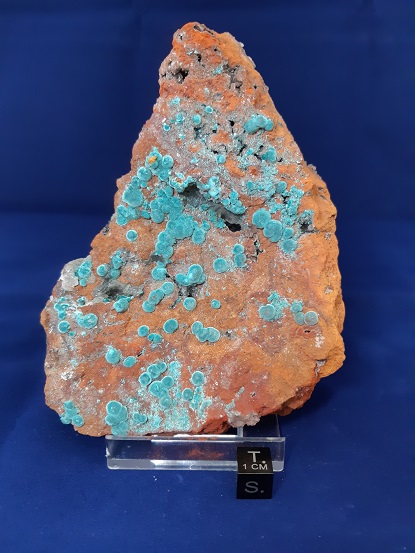
Dana Collection Sample Number 8309 – Rosasite
Ojuela Mine, Mapimi, Durango, Mexico
Specimen donated by Nancie Irving from the Al Kington Collection.
Rosasite is a carbonate mineral with chemical formula (Cu,Zn)2(CO3)(OH)2. It typically forms as balls or coatings on rocks, and is often associated with red limonite and other colorful minerals.
Fairholme Reef Complex, Alberta, Canada - Rugose Corals, Brachiopods, and Bryozoans
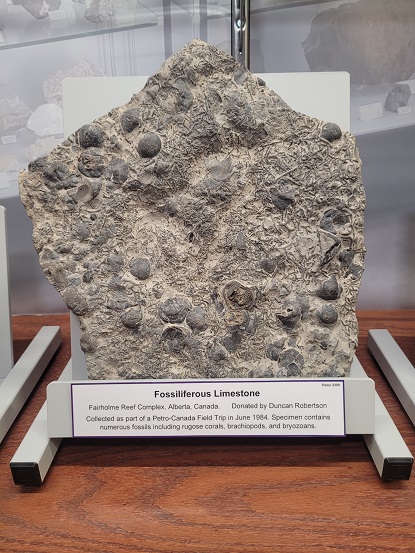
Paleontology Collection Sample Number 3399 from
Fairholme Reef Complex, Alberta, CanadaPlate of multiple fossil species (rugose, brachiopods, bryozoans). Rugose corals are both solitary and colonial corals that were abundant in Middle Ordovician to Late Permian seas. Brachiopods are animals that have hard "valves" on their upper and lower shell surfaces, which can be opened for feeding or closed for protection. Bryozoans are simple, aquatic invertebrate animals, about 0.5 millimetres long, and mostly living in sedentary colonies. All these organisms are filter feeders.
Specimen donated by Western University Earth Sciences Alumni Duncan Robertson. Sample collected as part of a Petro-Canada Field Trip led by UWO Alumnus Dr. Gordon E. Tebbut in June, 1984.
Greens Creek, Alaska, USA - Massive Argillite (MA)
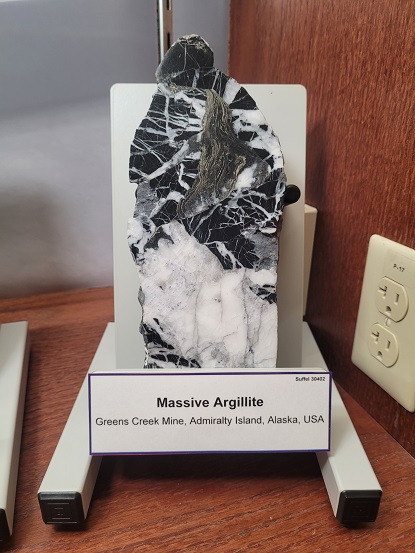
Suffel Sample Number 30402 from Greens Creek Mine
Admirality Island, Alaska, USA.
Greens Creek Mine is the largest silver mine in the United States, and is one of the largest silver mines in the world.
Hanging wall lithology located above the basal polymictic conglomerate. This specimen is of the massive argillite (MA) - dolomitic argillite typically found close to the base of the Hyd group. Beds tend to be 1" to 10" thick and have quartz-carbonate ladder veining normal to bedding due to post depositional folding. Conodont samples have provided a Carnian-Norian age of 220Ma. Description from Hecla Mining NI43-101 April 2019.
Specimen donated by Hecla Mining per Dr. Dean McDonald. Dr. McDonald is the current Richard W. Hutchinson Visiting Industrial Professor in Mineral Deposit Studies, and former Senior VP Exploration for Hecla Mining.
Greens Creek, Alaska, USA - Massive Fine Base Metal (MFB) Mineralization
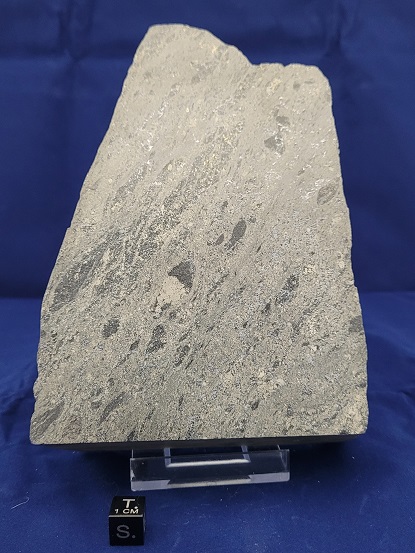
Suffel Sample Number 30405 from Greens Creek Mine
Admirality Island, Alaska, USA.
Greens Creek Mine is the largest silver mine in the United States, and is one of the largest silver mines in the world.
Sample of ore mineralization type Massive Fine Base Metal (MFB). This type of mineralization has >50% sulfide with sphalerite, galena and tetrahedrite dominating over pyrite. Textures are similar to MFP (30406) material but with more sphalerite and galena. Description from Hecla Mining NI43-101 April 2019.
Specimen donated by Hecla Mining per Dr. Dean McDonald. Dr. McDonald is the current Richard W. Hutchinson Visiting Industrial Professor in Mineral Deposit Studies, and former Senior VP Exploration for Hecla Mining.
Greens Creek, Alaska, USA - White Carbonate-Rich (WCA) Mineralization
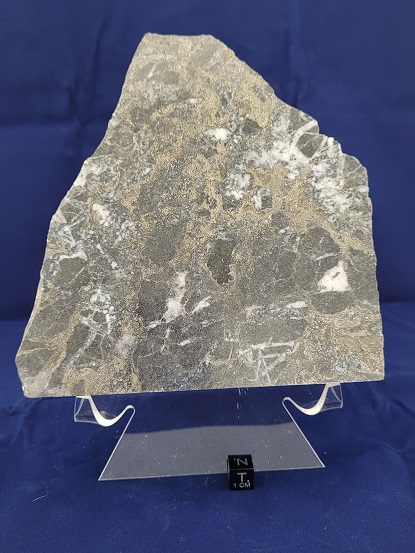
Suffel Sample Number 30409 from Greens Creek Mine
Admirality Island, Alaska, USA.
Greens Creek Mine is the largest silver mine in the United States, and is one of the largest silver mines in the world.
Sample of ore mineralization type White Carbonate-Rich (WCA). This type of mineralization contains less than 50% sulfide by volume and is dominated by carbonate gangue. Pyrite, sphalerite, galena, tetrahedrite and chalcopyrite are the dominant sulfides while dolomite, calcite, Ba-carbonate, biotite, barite quartz, muscovite and graphite make up the gangue. The carbonate material tends to be massive and recrystallized due to metamorphism. Carbonate veining is common to the unit. Description from Hecla Mining NI43-101 April 2019.
Specimen donated by Hecla Mining per Dr. Dean McDonald. Dr. McDonald is the current Richard W. Hutchinson Visiting Industrial Professor in Mineral Deposit Studies, and former Senior VP Exploration for Hecla Mining.
O'Brien Mine, Cobalt, Ontario, Canada - Silver Ore
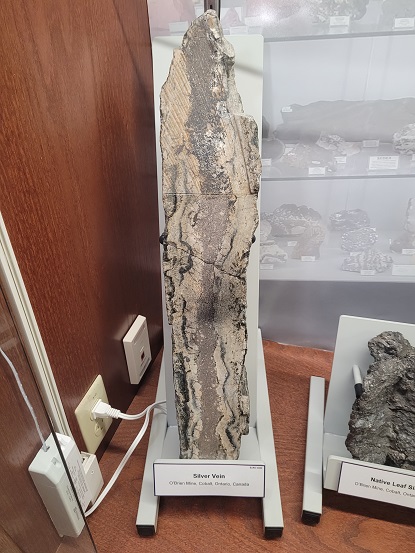
Suffel Collection Sample Number 3692 from O'Brien Mine
Cobalt, Ontario, Canada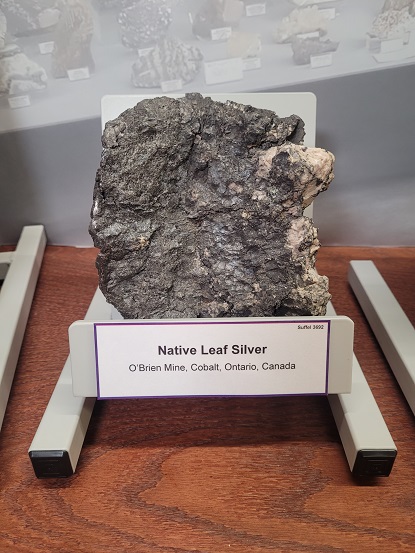
Suffel Collection Sample Number 3692 from O'Brien Mine
Cobalt, Ontario, Canada
The O’Brien Mine was the longest continuously operating mine in the Cobalt area of Ontario from 1905 to 1967. Total production was approximately 3.7 million lbs. of Cobalt, Copper, and Nickel combined and approximately 41 million oz. of Silver and Gold combined.
This specimen is comprised of two pieces. The first is an approximately 2 foot long section of complete silver vein, approximately 3 to 4.5 inches wide. There is calcite with native silver zone in the centre and arsenides elsewhere. The second specimen is a large chunk of leaf silver.
Specimens were secured by Dr. J.W. Russel in about 1924, and added into the collection by Dr. G. Gordon Suffel in November 1955. Dr. Suffel was a professor in mineralogy and economic geology at Western University from 1946 until his retirement in 1971. Dr. Suffel collected and donated thousands of specimens to the Suffel Collection during his time at Western University, as well as curated the Suffel Collection for over 20 years. His hard work and dedication made the collection the invaluable resource it is today, and is why the collection has been named in his honour.
Richard W. Hutchinson Collection - Gold
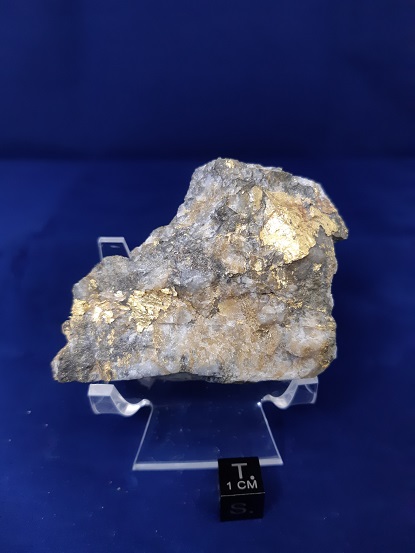
Dana Collection Sample Number 8196 – Gold
Location Unknown
Gold is a malleable metal that often occurs as nuggets or grains, in rocks, veins, and alluvial deposits. This specimen was labelled as one of "Dad's favourite rocks".
Specimen donated by Dr. Richard W. Hutchinson's family. Dr. Hutchinson was a professor in economic geology at Western University from 1964-1983. His work on volcanogenic massive sulphide (VMS) deposits resulted in a fundamental shift in thinking to understand the essential synvolcanic nature of these deposits. His continuing research provided exploration criteria that are critical to the global search for VMS deposits today. Together with Dr. Robert Hodder he dedicated a large portion of his tenure at Western to collecting, adding and cataloguing specimens for the G. Gordon Suffel Ore Deposit Collection. During his time as curator, the collection almost doubled in size. Dr. Hutchinson was a visionary scientist able to bridge the gap between the world of academia and the practical world of exploration. Perhaps his greatest legacy is evidenced by the success of a generation of students he inspired at Western, with many becoming prominent industry leaders and scholars who are able to pass on his passion for geology to future generations.
Richard W. Hutchinson Collection - Calcite and Copper
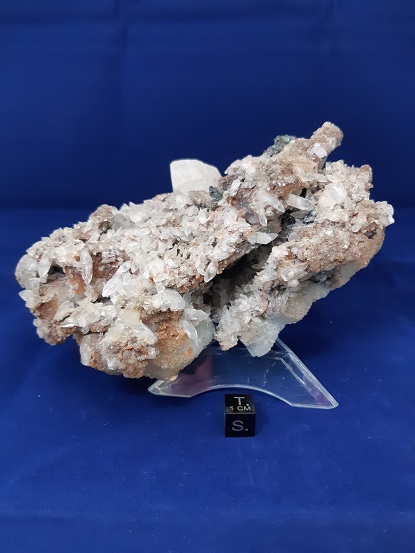
Dana Collection Sample Number 8294 – Calcite and Copper, some Druzy Quartz
Copper Corp Mine, Algoma District, Ontario, Canada
Calcite, chemical formula CaCO3, is a soft carbonate mineral. You may be familiar with it's fine grained variety, in the form of chalk. In this sample, the calcite forms many 1-2cm crystals, covering the specimen. Quartz is a hard, crystalline mineral composed of silicon dioxide that can be a variety of different colours. The variety “druzy quartz” is typically a layer of minute quartz crystals that has a sugar-like appearance. Copper is an orange, malleable native element and mineral that is used in electronics and wiring. Copper tarnishes green as it weathers. There are small blebs of copper located amongst the quartz crystals in this specimen.
Specimen donated by Dr. Richard W. Hutchinson's family. Dr. Hutchinson was a professor in economic geology at Western University from 1964-1983. His work on volcanogenic massive sulphide (VMS) deposits resulted in a fundamental shift in thinking to understand the essential synvolcanic nature of these deposits. His continuing research provided exploration criteria that are critical to the global search for VMS deposits today. Together with Dr. Robert Hodder he dedicated a large portion of his tenure at Western to collecting, adding and cataloguing specimens for the G. Gordon Suffel Ore Deposit Collection. During his time as curator, the collection almost doubled in size. Dr. Hutchinson was a visionary scientist able to bridge the gap between the world of academia and the practical world of exploration. Perhaps his greatest legacy is evidenced by the success of a generation of students he inspired at Western, with many becoming prominent industry leaders and scholars who are able to pass on his passion for geology to future generations.
San Sebastian, Durango, Mexico - Hugh Zone
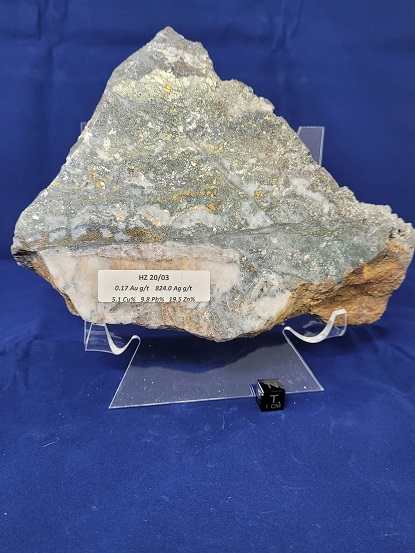
Suffel Sample Number 30392 from San Sebastian
Durango, Mexico
San Sebastian is located in the Mexican Silver Belt, and mining of high-grade ore took place between 1995-2001, and again from 2015-2020. During production, it produced some of the highest-grade silver in Mexico.
Polymetallic hand sample collected from the Hugh Zone of the Francine Vein. Analysis of this sample shows gold and silver concentrations of Au 0.17 ppm, Ag 824.00 ppm. Net Smelter Return (NSR) of samples in this area is between $200-400 per tonne.
Specimen donated by Hecla Mining per Dr. Dean McDonald. Dr. McDonald is the current Richard W. Hutchinson Visiting Industrial Professor in Mineral Deposit Studies, and former Senior VP Exploration for Hecla Mining.
San Sebastian, Durango, Mexico - Upper Base Metal Zone
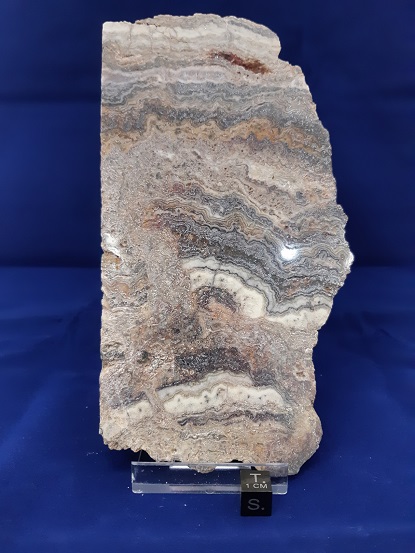
Suffel Sample Number 30392 from San Sebastian
Durango, Mexico
San Sebastian is located in the Mexican Silver Belt, and mining of high-grade ore took place between 1995-2001, and again from 2015-2020. During production, it produced some of the highest-grade silver in Mexico.
East Francine Vein Hand Sample. Sample collected from the pit near the intersection of East Francine and Francine veins. From the upper base metal zone. May have supergene enrichment.
Specimen donated by Hecla Mining per Dr. Dean McDonald. Dr. McDonald is the current Richard W. Hutchinson Visiting Industrial Professor in Mineral Deposit Studies, and former Senior VP Exploration for Hecla Mining.
Yellowknife, Northwest Territories, Canada - Diatreme
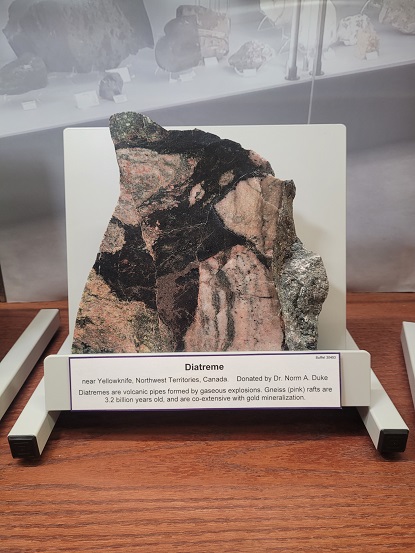
Suffel Collection Sample Number 30453
Yellowknife, Northwest Territories, Canada
From a diatreme at Yellowknife. Gneiss rafts are 3.2 billion years old and are co-extensive with gold mineralization. A diatreme is a volcanic pipe that is associated with a gaseous volcanic eruption.
Specimen donated by Dr. Norm A. Duke. Dr. Duke was a professor in economic geology at Western University from 1984 until 2015, and is currently an emeritus professor in the Earth Sciences Department. Dr. Duke is also one of the former curators of the Dr. G. Gordon Suffel Ore Deposits Collection. The main focus of Dr. Duke's research has been in conducting regional metallogenic analysis, i.e. placing ore forming processes within regional structural/stratigraphic frameworks based on field relationships.

